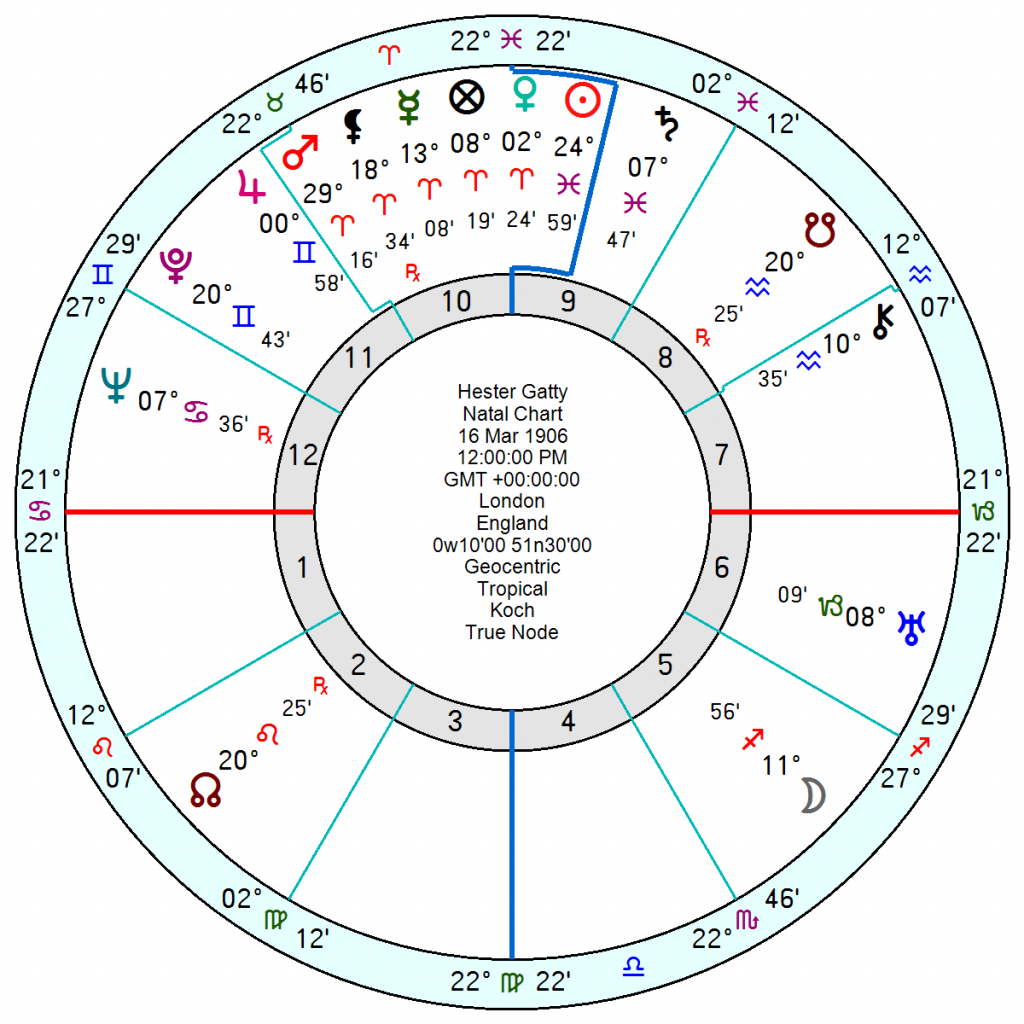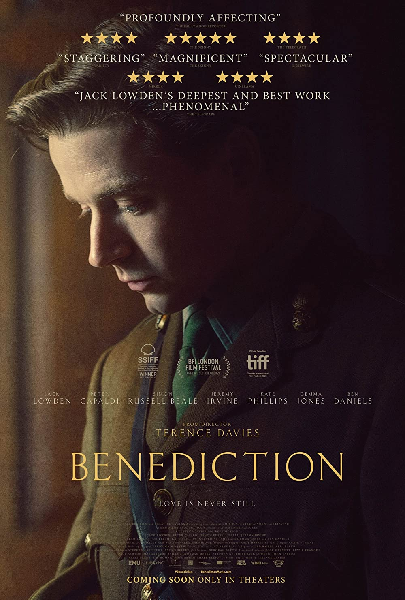




The haunting and haunted life of leading World War One poet Siegfried Sassoon is being re-examined in Terence Davies’ Benediction, a biopic about personal loss, wasted life and talent unfulfilled – a man betrayed by himself. Decorated for bravery on the Western Front and described as recklessly courageous, Sassoon turned against the war, writing poetry about the horror of the trenches and his 1917 Soldier’s Declaration against the continuation of the war became a cause celebre. Though also earned him a stint in the Craiglockhart psychiatric hospital, engineered by a friend to avoid charges of treason, dramatized in Pat Barker’s Regeneration novels and films. There he met Robert Graves and another leading war poet shell-shocked Wilfred Owen with whom he shared a strong bond.
Owen’s Anthem for Doomed Youth “What passing-bells for these who die as cattle?” became even more poignant when he was killed within a week of the Armistice in 1918.
After the war in the 1920s Sassoon wrote the Sherston Trilogy of novels, really a fictionalised autobiography – Memoirs of a Foxhunting Man etc – and conducted a series of homosexual affairs including one with Ivor Novello. He married when he was forty and had a son though the marriage split after 12 years.
An earlier biographer remarked of him that he had lived posthumously since the war.
He was born 8 September 1886 Tunbridge Wells with a rectified time of 5.22am. He was a Sun Virgo sextile Saturn in Cancer on one side and sextile Mars in Scorpio on the other, with his Sun sitting on his Mars/Saturn midpoint – which suited him for a military career but would also be inclined to depression. His parents split when he was four and his father died five years later. His hard-working Capricorn Moon opposed his Saturn which would exacerbate his tendency to the glooms though a lucky, adventurous Uranus Jupiter in a confident trine to Pluto would help to add a counter-balance. His Venus Mercury square Neptune would foster his creative talents.
I must admit to struggling to pinpoint the effects of the war on him astrologically-speaking. The two outermost planets Pluto and Neptune were both on the cusp of a sign shift as the war began and in the early stages – Pluto at zero Cancer as war broke out and Neptune into Leo shortly after. One partial clue may be his North Node in Virgo, maybe in the 12th, which would make him unusually open to others’ pain. He was on a Half Nodal Return in 1914 when the war began with the Eclipses in Pisces.
By 1917 when his tolerance for the horror had gone the transiting Node was conjunct his Moon and opposition his Saturn. He did seem to be unduly sensitive to his Node. His Progressed Mars did oppose his Pluto which is more suggestive of a catastrophic and soul-searing phase but that was not until 1919/20. Though it may have been a delayed reaction.
His friendship with Wilfred Owen, 18 March 1893, was close though probably not sexual. Owen was born two months after Ivor Novello, a later liaison, 15 January 1893, with both having the Neptune Pluto in Gemini on Sassoon’s Midheaven. And Owen like his wife Hester Gatty, 16 March 1906, had a Pisces Sun in Sassoon’s relationship 7th house.
All a muddle – as if each relationship offered him part of what he needed but it was never enough.
His wife, Hester Gatty, had her Saturn conjunct his Pisces South Node which suggests at some level she may have pulled him back into the past. Though (his birth time being accurate) her Sun Venus in his 7th would help to give him an uplift.
Not sure I am much the wiser.
Add ON:
Sassoon’s 12th harmonic of the victim is prominent with a Grand Trine, formed into a Kite by a war-like Saturn opposition Pluto and destructive Pluto square Mars.
Sassoon quotes:
“Sneak home and pray you’ll never know
The hell where youth and laughter go.
Look down, and swear by the slain of the War that you’ll never forget.”
“I died in hell. They called it Passchendaele.”
“Soldiers are citizens of death’s grey land, drawing no dividend from time’s tomorrows.”
“For death has made me wise and bitter and strong;
And I am rich in all that I have lost.”
“I know that he is lost among the stars,
And may return no more but in their light.”

Thanks Marjorie. Very sad and thought provoking, particularly Sassoon’s ‘posthumous’ existence after the First World War ended.
I noticed that in 1918-1919 there was a fixed sign opposition between Saturn in Leo and Uranus in Aquarius. This would have been transiting his Venus in Leo and Neptune in Taurus – and the Neptune of so many of those devastated or killed by the War itself, and those who loved them. For each life lost or wounded, there are families, children, siblings and friends who were affected by those events, every time. Considering the numbers of revolutions, wars, genocide and civil wars during (just) the 19th century as a whole, there can scarcely be a family that hasn’t been touched by these endless outbreaks of violence in our human history, and on into the lives of their descendants.
Looking at conflicts erupting in Europe, Saturn in the fixed signs seems to have a part to play in those endless echoes. Saturn in Aquarius offers one such pattern.
The after-effects of the Napoleonic Wars (1803-1815) lead up, in a way, to the background for the two World Wars too, since they led to the initial unification of Germany (June 1815). What caught my attention is Saturn in Aquarius (12) in 1815, the opposite sign from the end of World War 1. Young adults at that time would have had great-grandparents who were alive during the Napoleonic Wars.
Saturn was also at 7 Aquarius in January, 1933 at the official start of the Third Reich. In April 1992, at the start of the War in Bosnia, Saturn was 16 Aquarius. Saturn was 12 Aquarius in January this year, returning again to June 1815’s degree. Someone said something like those who don’t learn from history are condemned to repeat it. Saturn, planet of history and time, is possibly wondering when we will ever learn.
He was a close friend of Robert Graves during the war but the two fell out over confidences betrayed in the latters book Goodbye To All That. After the war he became a good friend of another Great War poet and author Edmund Blunden. All three of these young poets survived long after the conflict but each of them in some way “died” during it.
I am still thinking about ‘Boris Johnson – puppet dancing on a cliff edge ++ driven by demons from the distant past’.
So many of us had grandparents/great grandparents who physically survived WWI but had to live with the memories of Passchendaele, Ypres, the Somme etc. I certainly did. I wonder what demons succeeding generations inherited and/or were driven by.
Even the Bible makes mention of this in Numbers and Exodus “…visiting the iniquity of the fathers upon the children, even unto the third and fourth generation.” So a psychological principle recognised even in antiquity. As somone else here has mentioned, it continues until brought into the light of consciousness and is transformed through healing into something positive. I guess that’s why no one has a pain free existence.
In his biiwheel, Tropiical inside, Draconic outside, notice how the draconic chart shows him finding his soul’s true path.
Venus in his tropical chart is hidden in hiss 12th House, but after all his life experiences, Venus, poetry, in his Draconic, becomes exalted in Pisces
in his 7th House and Mars changes to Gemini in his 9th House of publication. He published poems with an antiwar theme. Check your Draconic chart and find your soul’s true career path.
In the Tropical, his Nodal axis was hidden in his depresseive 12th House but once he found his true life path, the Draconic Nodal Axis moved
to his 1st ans 7th House of public projeetion, love of poetry, as echod by his Draconic Venus exalted in Piscces, 7th.
https://i.postimg.cc/GpbLLwm1/Sassoon-Draconic-Biwheel.jpg
I have Lunar North Node at Aries 0 in my natal chart.
I believe that means my Draconic chart is simply the same as my regular natal chart.
Is that correct?
I hadn’t heard before of this man’s tragic, brave, sad life. Thank you for another interesting profile.
This kind of story, if well made cinema, seems like the kind of thing that leads to Academy Awards.
My main take away is that anti-war protesting and bisexuality are both nothing new, but have been present to some degree as long as war and sex have been part of the human condition. It’s not clear from the write up if his wife was aware of his interest in men.
The quotes show a writer who was deep, thought provoking, passionate.
P.S. I skip commenting on some of the modern politics posts, where I don’t already know the political situation. Don’t know if it would be appropriate to only remark on the astrology, without awareness of the rest of it.
Look at Sassoon’s biwheel, Tropical inside and Draconic outside….we see his soul’s
change in later life. In tropical his Mars was in Scorpio but with later life experiences
Mars changes to Gemini in his 9th House of published idease. Venus, hidden, in his
12th House in his tropical chart, changes to exaltation in Pisces in his 7th Hose of
Public projection….Venus rules poetry and this area of his life is pushed to the forefront.
In his tropical chart it was Mutible emphases but in his Draconic the emphasis was
Cardinal and he took to the initiative and changed his views on life thru’ his poetry.
Click this link to see his Tropical/Draconic biwheel…..note the changes and the
interaspects……… https://i.postimg.cc/GpbLLwm1/Sassoon-Draconic-Biwheel.jpg
Ideas from the book: Chasing Dragons by Viktor Olliver